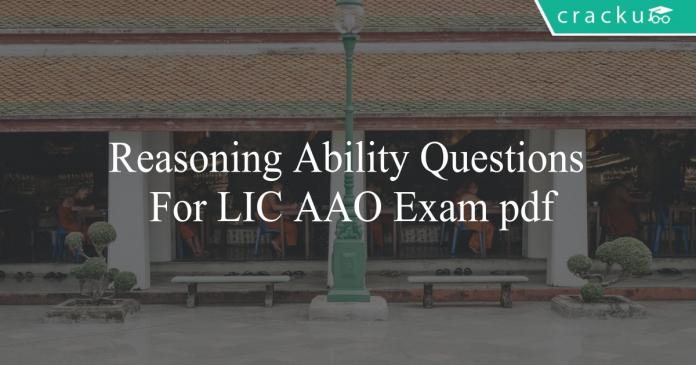Reasoning Ability Questions For LIC AAO Exam PDF:
Download Important Reasoning Ability questions for LIC AAO exam. Top 10 Reasoning questions with answers based on previous year asked questions.
Download Reasoning Ability Questions For LIC AAO Exam PDF
10 LIC AAO Mock Tests – Just Rs. 117
Download LIC AAO Previous Papers PDF
Take a free mock test for LIC AAO
Instructions
In each of the following questions, relationship between different
elements is shown in the statements. The statements are followed by two Conclusions
numbered I and II. Study the Conclusions based on the given statement and select the
appropriate answer.
Give answer a: if neither Conclusion I nor Conclusion II is true
Give answer b: if either Conclusion I or Conclusion II is true
Give answer c: if only Conclusion II is true
Give answer d: if both the Conclusion I and Conclusion II are true
Give answer e: if only Conclusion I is true
Question 1: Statements :
V < E > B = H ≥ N ; B ≤ T
Conclusions :
I. T > V
II. N ≤ T
a) if neither Conclusion I nor Conclusion II is true
b) if either Conclusion I or Conclusion II is true
c) if only Conclusion II is true
d) if both the Conclusion I and Conclusion II are true
e) if only Conclusion I is true
Question 2: Statements :
L = I ≥ N < E ; N ≥ S
Conclusions :
I. S = L
II. L > S
a) if neither Conclusion I nor Conclusion II is true
b) if either Conclusion I or Conclusion II is true
c) if only Conclusion II is true
d) if both the Conclusion I and Conclusion II are true
e) if only Conclusion I is true
Question 3: Statements :
L = I ≥ N < E ; N ≥ S
Conclusions :
I. S < E
II. E > L
a) if neither Conclusion I nor Conclusion II is true
b) if either Conclusion I or Conclusion II is true
c) if only Conclusion II is true
d) if both the Conclusion I and Conclusion II are true
e) if only Conclusion I is true
Download LIC AAO Previous Papers PDF
100 Free Computer Awareness Tests for LIC
Question 4: Statements :
B > E ≥ A < L; T ≥ A > S
Conclusions :
I. B > S
II. L > S
a) if neither Conclusion I nor Conclusion II is true
b) if either Conclusion I or Conclusion II is true
c) if only Conclusion II is true
d) if both the Conclusion I and Conclusion II are true
e) if only Conclusion I is true
Question 5: Statements :
B > E ≥ A < L; T ≥ A > S
Conclusions :
I. T ≥ B
II. L > T
a) if neither Conclusion I nor Conclusion II is true
b) if either Conclusion I or Conclusion II is true
c) if only Conclusion II is true
d) if both the Conclusion I and Conclusion II are true
e) if only Conclusion I is true
100 Free GK Tests for Insurance Exams
Instructions
In each of the questions given below two/ three statements
followed by two conclusions numbered I and II have been given. You have to take the
given statements to be true even if they seem to be at variance from commonly known
facts and then decide which of the given conclusions logically follows from the given
statements disregarding commonly known facts.
Give answer a: if neither Conclusion I nor Conclusion II follows
Give answer b: if either Conclusion I or Conclusion II follows
Give answer c: if only Conclusion II follows
Give answer d: if both the Conclusion I and Conclusion II follow
Give answer e: if only Conclusion I follows
Question 6: Statements:
No sea is a lake.
Some lakes are rivers.
All rivers are oceans.
Conclusions :
I. Atleast some oceans are lakes
II. All rivers are lakes.
a) if neither Conclusion I nor Conclusion II follows
b) if either Conclusion I or Conclusion II follows
c) if only Conclusion II follows
d) if both the Conclusion I and Conclusion II follow
e) if only Conclusion I follows
Question 7: Statements:
No sea is a lake.
Some lakes are rivers.
All rivers are oceans.
Conclusions :
I. No sea is a river.
II. All oceans are lakes.
a) if neither Conclusion I nor Conclusion II follows
b) if either Conclusion I or Conclusion II follows
c) if only Conclusion II follows
d) if both the Conclusion I and Conclusion II follow
e) if only Conclusion I follows
Question 8: Statements:
All kittens are cubs.
No kitten is a puppy.
Conclusions :
I. All puppies being cubs is a possibility.
II. All cubs are kittens.
a) if neither Conclusion I nor Conclusion II follows
b) if either Conclusion I or Conclusion II follows
c) if only Conclusion II follows
d) if both the Conclusion I and Conclusion II follow
e) if only Conclusion I follows
Question 9: Statements:
Some rooms are stores.
All stores are godowns.
All godowns are warehouses.
Conclusions :
I. All warehouses being rooms is a possibility.
II. Atleast some godowns are rooms.
a) if neither Conclusion I nor Conclusion II follows
b) if either Conclusion I or Conclusion II follows
c) if only Conclusion II follows
d) if both the Conclusion I and Conclusion II follow
e) if only Conclusion I follows
Question 10: Statements:
Some rooms are stores.
All stores are godowns.
All godowns are warehouses.
Conclusions :
I. All rooms are godowns.
II. All stores are warehouses.
a) if neither Conclusion I nor Conclusion II follows
b) if either Conclusion I or Conclusion II follows
c) if only Conclusion II follows
d) if both the Conclusion I and Conclusion II follow
e) if only Conclusion I follows
LIC AAO REASONING QUESTIONS PDF
Question 11: What does R work as ?
a) Doctor
b) Engineer
c) Singer
d) Journalist
e) Designer
Question 12: Four of the following five are alike in a certain way, and so form a group. Which one of
the following does not belong to that group ?
a) N, Teacher
b) R, Engineer
c) P, Policeman
d) S, Journalist
e) M, Author
Question 13: Who amongst the following is a Designer?
a) M
b) P
c) S
d) T
e) R
Question 14: Which of the following statements is TRUE as per the given arrangement?
a) Only one person sits between S and 0.
b) The Engineer sits second to the left of 0.
c) S is a Teacher.
d) All the given options are true.
e) The Author sits to the immediate left of T
Question 15: Who sits exactly between N and M, when counted from the right of M?
a) S
b) T
c) 0
d) Other than those given as options
e) R
Instructions
Study the following information carefully and answer the questions given below :
When a word and number arrangement machine is given an input line of words and numbers, it arranges them following a particular rule. The following is an illustration of input and rearrangement.
(All the numbers are two digit numbers)
Input : 24 method 87 67 of data 34 collection 45 12 specified now
Step I : 12 method 87 67 of data 34 collection 45 specified now 24
Step II : 34 12 method 87 67 of data collection specified now 24 45
Step III: 67 34 12 method of data collection specified now 24 45 87
Step IV : collection 67 34 12 method of specified now 24 45 87 data
Step V : method collection 67 34 12 of specified 24 45 87 data now
Step VI: of method collection 67 34 12 24 45 87 data now specified
Step VII is the last step of the above arrangement as the intended arrangement is obtained.
As per the rules followed in the given steps, find out the appropriate steps for the given input.
Input : chemical 68 11 reaction 87 is 21 hard to 53 92 detect
Question 16: Which element is exactly between ‘chemical’ and ’87’ in the second step of the given
arrangement?
a) 53
b) hard
c) reaction
d) is
e) 68
Question 17: Which element is fifth to the left of the element which is ninth from the left end of the
fourth step?
a) 11
b) 87
c) 53
d) reaction
e) chemical
Question 18: In which step are the elements ’87 53 11 reaction’ found in the same order?
a) Sixth
b) Fifth
c) Fourth
d) Fourth and Fifth
e) None of these
Question 19: What is the position of ’21’ from the right end in the last step?
a) Tenth
b) Eighth
c) Fifth
d) Fourth
e) Sixth
Question 20: In which step are the elements to 92 detect 21′ found in the same order?
a) Sixth
b) Second
c) The given order of elements is not found in any step.
d) Third
e) Fifth
HDFC EGRO will be the insurance company providing the cover for the Rupay card offered under the Pradhan Mantri Jan Dhan Yojana. It is an Indian assurance firm which is headquartered in Mumbai.
Download General Science Material PDF
Answers & Solutions:
1) Answer (C)
2) Answer (B)
3) Answer (E)
4) Answer (D)
5) Answer (A)
6) Answer (E)
7) Answer (A)
8) Answer (E)
9) Answer (D)
10) Answer (C)
11) Answer (D)
12) Answer (A)
13) Answer (B)
14) Answer (E)
15) Answer (C)
16) Answer (C)
17) Answer (A)
18) Answer (D)
19) Answer (E)
20) Answer (B)





